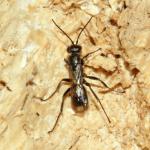An all-black species with bifasciate wings. It most resembles Dipogon bifasciatus from which it may be told in the female by the shorter antenna; the third segment being about equal in length to the scape and subequal to the fourth. The male has crenulate antennae and a subgenital plate with short hairs medially.
Widely distributed in England especially in the east, very local in Wales, and limited to a small area in Scotland. It is apparently unrecorded from Ireland.
This wasp is a species favouring woodland and hedgerows where dead wood provides suitable nesting sites and the prey species occurs.
June to September.
The prey is apparently exclusively the spider Segestria senoculata (Araneae: Segestriidae). Each spider is carried by its spinnerets to the nest. The prey is then malaxated. The exact purpose of this is not clearly understood but it may be a form of "host-feeding", a practice not uncommon in ichneumonids, in which the wasp obtains proteins necessary for egg production; certainly this species and its congeners are rarely, if ever, recorded visiting flowers.
The nest is made in pre-existing cavities, usually crevices or old beetle holes in wood but possibly also in walls. The cavity is sealed in part by spider's silk applied with the female's maxillary bristles.
No flower visits have been recorded. This species has been recorded running over dead wood and from Malaise traps.
No information available.


